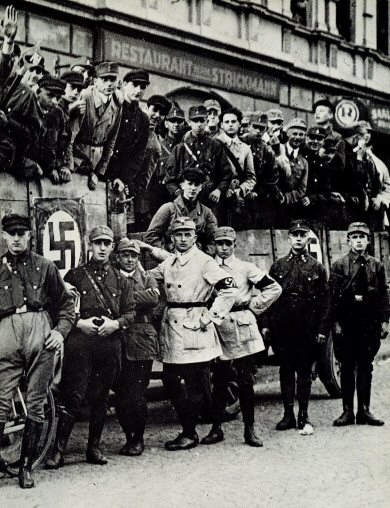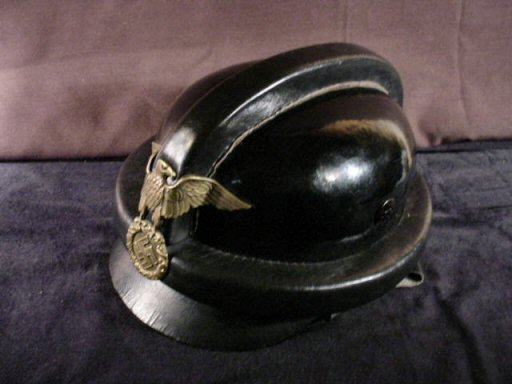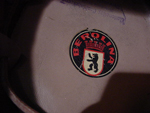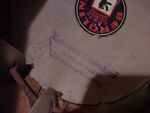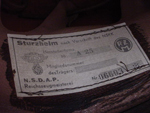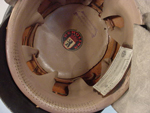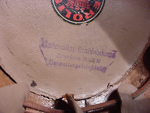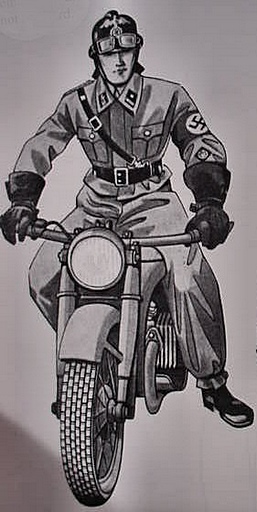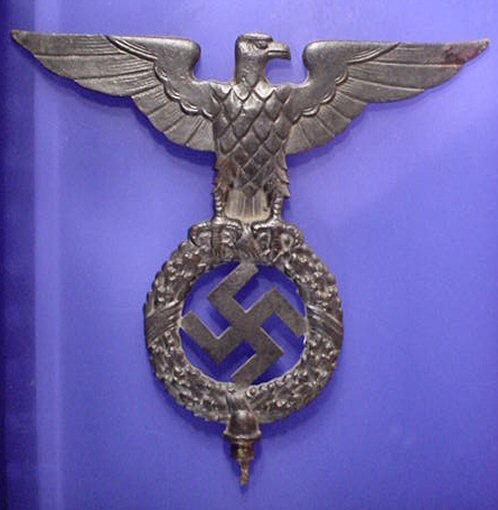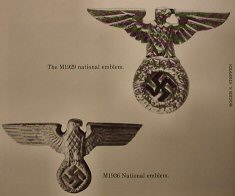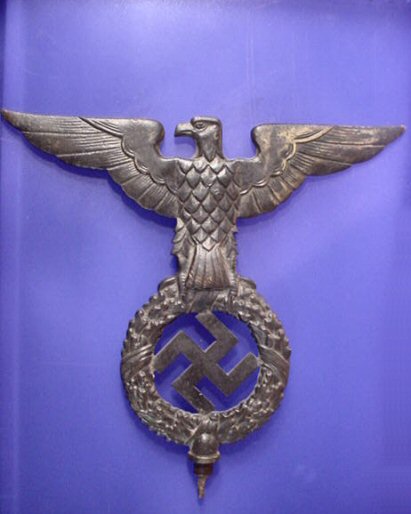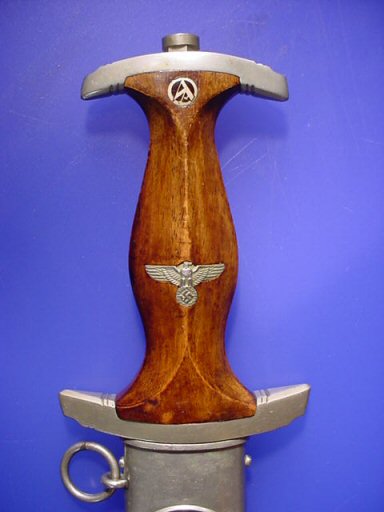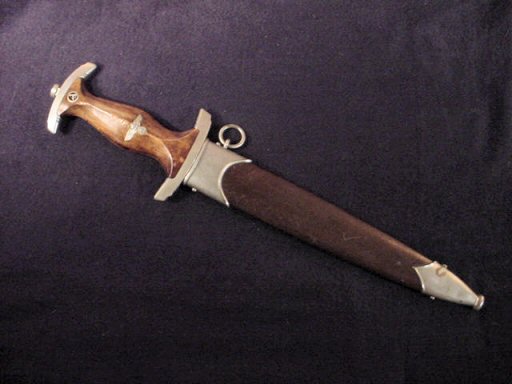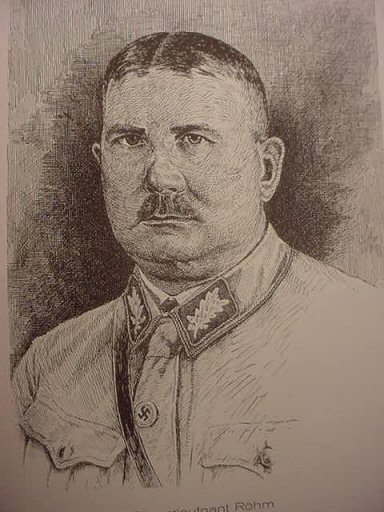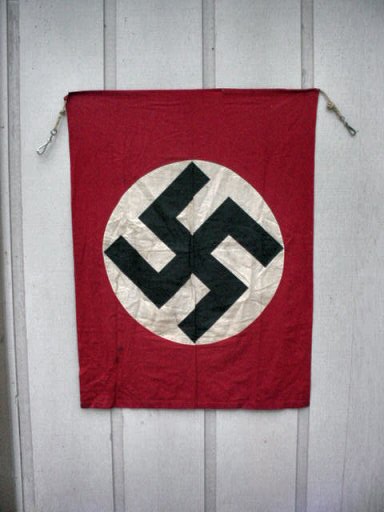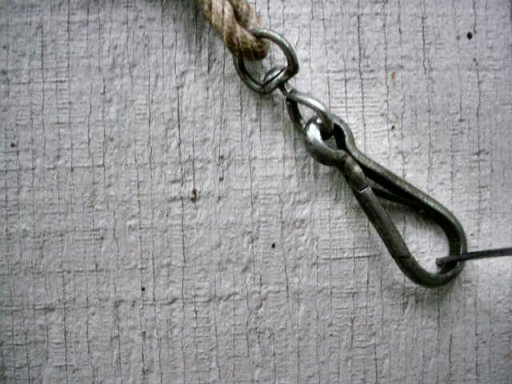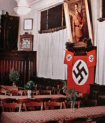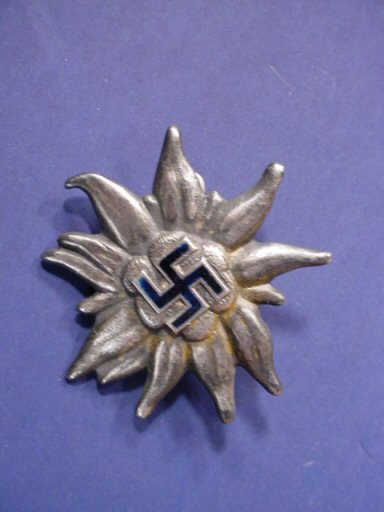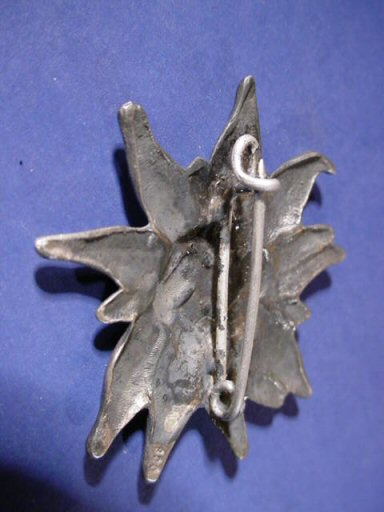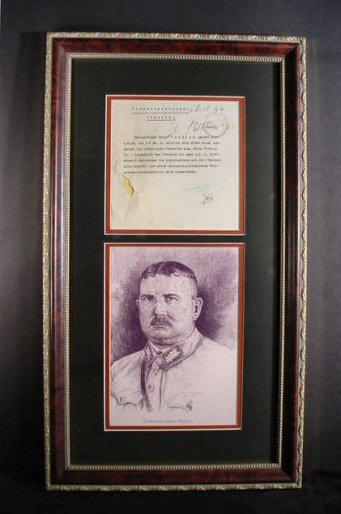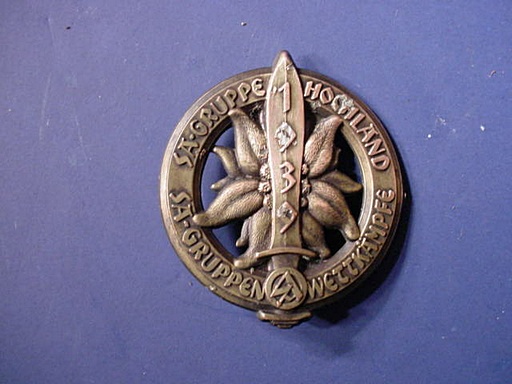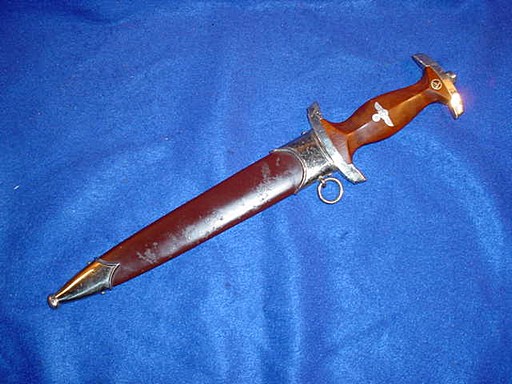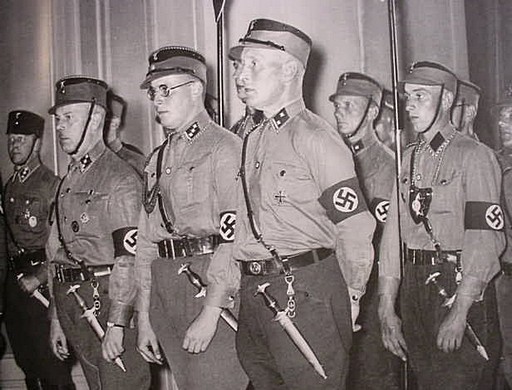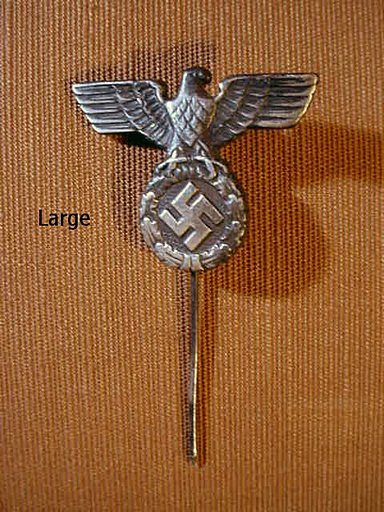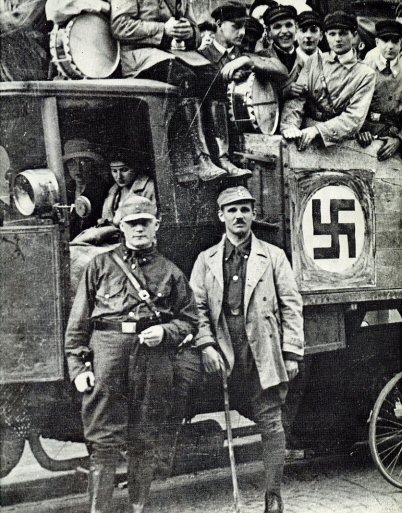|
|
|
|
Sturmabteilungen
The SA
Page 11
|
|
|
||||||||||||||||||||||||
|
NSKK Crash Helmet Sturtzhelm (Item SA 11-1) |
||||||||||||||||||||||||
| DESCRIPTION: This is the NSDAP’s motorized section known as the Nationalsozialistiche Krafahr Korps. This section of the party apparatus was formed in 1931 and the original purpose was to gather automobile owners and drivers into Storm Trooper (SA) units that enabled NS party members to travel for political events and rallies. At this point, automobiles were still a luxury in Germany and relatively few people could afford them; hence, requisitioning their use through volunteers avoided the need to acquire funds for their direct purchase. A smaller organization known as the Motor SA (MSA) was also integrated into the NSKK in 1934. This unit was composed of motorbikes, cars, and trucks that were previously used by the National Socialist Party. By 1938 the NSKK had more than 500,000 members divided into five districts where membership was strictly voluntary. As an organization the NSKK also encompassed two smaller branches within its structure which included the Motor Hitler Youth and the Naval NSKK. During wartime the NSKK was organized into transport companies that moved German troops to various locations. Members of the NSKK operated throughout Germany to include areas within the liberated territories. The NSKK adopted the Sturtzhelm, crash helmet, that had been worn by the Motor SA units as early as 1928. The only modification was the insignia used, molded smooth, blackened leather helmet with raised, padded protective bars running horizontally around the helmet’s bottom edge and another one running from front to back over the crown. It has one ventilation grommet to each side of the crown. The front-center of helmet has a large nickel/silver-plated alloy, early NSKK-pattern stylized national eagle that clutches a wreath-encompassed swastika. The eagle is mounted on the vertical raised padded bar and is bent back (purposely) to fit the contours of the helmet. The helmet has a short, blackened leather visor stitched to the front and stitched-on, blackened grained, leather protective side and rear panels, side panel with stitched-on closure flaps. The flaps were designed to protect the ears. Side panels also have extended straps to bottoms which act as the chinstrap. The liner is intact with all fingers and leather is still supple.
This helmet is in practically mint condition and considering the usage that this type headgear was put to, this is incredible! The helmet was manufactured by Berolina and the logo and name of the company is clearly seen in the intact label inside. The logo includes the traditional Berlin Bear with crown. There is also a stamped wording inside by the Bear label and it says Nationalsoz. Kraftfahrkorps-Motorsturm 35/M-30 Verwaltungsrienst. Inside the liner is the RZM label all intact but shows just enough wear to exhibit the fact that the helmet was at least worn if only occasionally. The issue No. 06693 is evident as well as another stamped no- A-25. We feel compelled to once more state that this is the finest example of the NSKK Sturzhelm we have ever seen or heard of in all our years in this field.
PRICE: SOLD |
|
||||||||||||||||||||||||||||
|
NSKK (Motor Corps) Outfit (Item SA 11-1a) |
||||||||||||||||||||||||||||
| DESCRIPTION: This is a great outfit that includes trousers, boots, and Sam Browne belt. This is a really rare ensemble for NSKK Truppführer (sergeant first class) of the Motorsturm 3 of the 464th Motorstandarte. This is indicated on the left collar tab or patch. The right has two pips indicating his rank. The shoulder board with alternating aluminum and black center is on a black base with colored piping that looks yellowish brown. The Sam Browne-type service belt has the bright chrome-finished buckle that’s described on page 89 of the book by John Angolia and David Littlejohn entitled Uniforms, Organization, and History of the NSKK/NSFK . We garnered other information as well from this great textbook on the subject. The belt has the leather loops for securing the cross strap to front and back. It also has the leather attachments for the suspension of the SA/NSKK dagger. The tunic, or blouse, has the swastika armband, and attached is the SA Wehrsportabzeichen (Sports Qualification Badge) in bronze. The blouse has the French cuffs held together with brown-colored pebbled buttons that match the front buttons on the garment. On the left sleeve is the diamond-shaped patch with a metallic NSKK eagle the NSKK cipher above. This sleeve insignia is of the early type as is the whole uniform, in fact (pre-1937). The collar patches or tabs are deep blue. Is this caused by the exposure to the sun or is it some special branch? The shirt and tie seen in the pictures are not original equipment and the party pin is also added to the ensemble. If the buyer wants these extras, we will throw them in that no extra charge. The trousers are the riding style with covered pockets, but one flap cover button is missing. The trouser legs are bloused and the part that goes in the boots is with tie strings (one of these strings is missing). Like the blouse, these are in very good condition, although unmarked. The size is small and the drivers of motor vehicles, especially motorcycles, were usually of small stature and immense bravery, especially in those early days of Strassekampf, the struggle against the reds in the late 1920s and 1930s. The boots that go with this grouping are the originals, for sure. They are standard political issue, with soft, leather uppers, while the shoe section is tougher with the front-quarter horsehide construction. They are in very good condition, without any thread loosening. Yes, they are a bit scuffed on the upper portions because of hard wear, but this can be remedied in 5 minutes with a can of black shoe polish and a rag. We don't touch these things; we leave them as we receive them. All in all, this is a really great uniform ensemble. Please check out the NSKK crash helmet at Item SA 11-1. This would complement this outfit nobly, but so would a side cap. Anyway, if you do not have the headgear this will put you well on your way to a great display of extremely rare vintage of NS official uniform wear. It would be tremendous on a mannequin.
PRICE: SOLD |
| |||
|
SA-SS Original Flagpole Top (Item SA 11-4; SS 29-8) |
|||
| DESCRIPTION: Here is a nice eagle flagpole top. It is in the typical early SA configuration with the sharp tip wings. This eagle was used both by the SA and the early SS formations. Because it is colored black instead of the usual SA silvered model we tend to believe it is SS; however, we cannot be at sure. The eagle is of the 1929 style. We do know it’s 100 percent original and a relic of the Kampfzeit, the early struggle for power from the 1920s to 1933. The black coloration does not seem to be painted on, rather, it appears to be a bluing process or blackening! Some brass shows through at some area. It is in very good shape except for some corrosion and the fastening screw at the bottom is stripped and corroded.
PRICE: SOLD |
|
|||||||||||
|
Personalized SA Dagger with Rare Proof Markings (Item SA 11-5) |
|||||||||||
| DESCRIPTION: This is a fine SA dagger that has the Haco Berlin proof mark. Tom Johnson on page 244 of his book series volume one lists this as an uncommon proof mark. It seems that this dagger was actually made in Berlin, the capital city, rather than being produced in the usual Solingen (City of Swords). Of course, more than 100 firms were operating at full capacity during this era producing all manner of Third Reich daggers, but still, 98 percent were Solingen firms. So, a Berlin-maker piece is considered a real rarity when encountered. NEXT, this is the seldom-encountered personalized blade. This one is engraved on the reverse side with the words in old-German script: “In Treuer Kameradenschaft June 19/M86 G. Eiker Sturmführer.” Translated: “In true comradeship in June 19/M86,” and the Sturmführer’s name. This is obviously a gift item from this SA officer to one of his fellow officers or one of his storm troopers. The ‘19/M86’ indicates that the unit was a motor Standarte. This is designated by the ‘M.’ The ‘19’ represents the Sturm, or storm troop, number, and the ‘86’ is the Standarten number. The Sturmführer was a storm-troop leader or a lieutenant, a lower rank in the army, but in the brown-shirt-storm sections this was a very important officer, who often was responsible for all the activities of his men. He and the Haupttruppführer had similar jobs that a master sergeant might have in U.S. equivalent ranks. On the cross guard of this dagger is the stamped letter ‘B.’ This means that the unit that the weapon belonged to was the Berlin-Brandenburg section of the SA. It seems the Sturmführer shopped close to home! The dagger is in good overall condition. The blade is fine except it may have been a bit sharpened back then. Remember, this weapon was often just that—a weapon. This one comes from “Red Berlin,” the toughest area to control of all the German cities in the 1920s and early 1930s. Often the SA man’s only defensive weapon would be his SA “Dolch” against the murderous communist red-front brigades, which had every weapon imaginable, including guns! Many SA troopers were viciously murdered during this turbulent time in what was the most dangerous city in the western world. The sharpening was professionally done and leaves no apparent scars. In fact, it is only discernable by feeling the edges. The engraved presentation is quite beautifully done and is crystal clear, but very difficult to photograph clearly. The ball tip of the scabbard is ruptured slightly, but that is all that one could call ‘damage.’ This is a very nice and very rare museum piece. It is prodigiously important and a collector would be very fortunate to be the owner.
PRICE: SOLD |
|
|||||||||||||||
|
Badly Preserved SA Document signed by Ernst Rohm (Item SA 11-6) |
|||||||||||||||
| DESCRIPTION: Items signed by Ernst Rohm are probably the scarcest of all NS relics. This document is in terrible shape, but it is original and has the SA staff chief’s clear signature. It is (was) a Kontrollblat, a record sheet, for an SA officer with an entire record of his qualifications and background. What’s left of it measures 8 x 12 inches. It has the signature of Rohm over an official “SA der NSDAP” stamp for Sturmbahn 31. Underneath Rohm’s signature is another; probably that of the particular storm-troop leader. Framed with a picture of Rohm this would make for an extremely rare historically important addition to an NS collection.
PRICE: SOLD |
|
|||||||||||||||||||||||
|
Another NS Banner (one sided) (Item SA 11-7; FLAG 3-7) |
|||||||||||||||||||||||
| DESCRIPTION: This one is in good shape and has rope and clip attachments for display on a pole or hooks on the wall. It is single-sided, so it is not a true flag. Rather, it was for display at an SA Sturm headquarters. This is the typical size and construction piece used as stated or even on trucks and personnel lorries that were used on early SA missions. The size is 40 x 30 inches. There are a few old stains in the white field, but they really don't detract from what is a nice memento of the Kampfzeit.
PRICE: $325.00 |
|
||||||||||
|
Gruppe Hochland Edelweiss Insignia or Jewelry Object (Item SA 11-8) |
||||||||||
| DESCRIPTION: This is an official piece which we acquired in Stuttgart a few years ago. It is an absolutely stunningly beautiful Edelweiss, the flower of the Alps, with enameled swastika in its center. The Edelweiss is crafted in silver. See About Our Rings and Silver Insignia. This insignia, about the size of a silver dollar and is marked with the ‘800’ silver designation stamped in the tip of one of the petals. The question that we always have emerges here: Is this a hat insignia, or is it jewelry? We know that insignia exactly like this were worn by the SA mountain units such as Gruppe Hochland, but an example we found a few years ago was made in pot metal and had a casting device that was with fold-over pins. But this one we offer is, first off, silver and has a jewelry-type clasp pin. It could be that this special Edelweiss was the deluxe model and was pinned to the cap or possibly worn somewhere else on the uniform??? In any case, it is genuine and beautiful. On page 8 of Cloth and Insignia of the NSDAP, by LTC (ret) John Angolia, a drawing of an SA Hochland Gruppe is shown and in it is noted that he wears the Edelweiss without stem. Members of the groups Alpenland, Donau, Hochland, and Südmark were permitted to wear this badge and Bavarian-style leather shorts. They were without doubt the most colorful, and the most loyal of the SA formations. This is truly a rare and great-looking badge.
PRICE: $475.00 |
|
|||||||||||||||
|
Document signed by Ernst Röhm, SA Staff Chief (Item SA 11-9) |
|||||||||||||||
| DESCRIPTION: This is a good-conduct report concerning an SA Rottenführer in the year 1934, who was probably being considered for promotion at that time. The document is a “Dienstleistungs-Zeugnis,” something similar to a testimonial. It translates to the statement that SA Rottenführer Heinz Andress has belonged to the SA since 1-3-32 and has a very good and strict character, his leadership and off-duty conduct is excellent. He is humble and helpful in his appearance, his comradeship, and his pure National Socialist outlook is without blemish. The note is signed by the Führer of the Sturmes 34/48 by a Sturmführer who hand signed it. At the top is the signature of SA Staff Chief Ernst Röhm with his stamp that is with the early SA eagle and is dated 20/1/34. The Röhm signature is final approval and certification of his having read it. Röhm documents are quite rare, especially with his signature as everything concerning him was removed or destroyed subsequent to his execution in June of 1934. Only 5 months after he signed this document he was dispatched by Hitler and the SS for planning an SA-lead coup against the party and the Führer. The event has become historically known as The Night of the Long Knives and it became synonymous with the famous purge. The behavior of much of the SA threatened Hitler’s political survival and the entire future of the National Socialist movement. There was the distinct possibility of a Putsch by Röhm’s forces. Röhm was arrested personally by Hitler with his SS commanded by Josef (Sepp) Dietrich. The arrest was made at the resort town of Bad Wiesse near Munich. Then he and many of his officers were transferred to Stadelheim Prison outside Munich where Röhm was subsequently shot by ranking officer, Theodore Eicke, commander of the Totenkopf (Death’s Head). Guards at Dachau entered the cells of the others and shot them point blank. Hitler on July 13 gave a long speech to the Reichstag in which he announced 74 had been shot and he justified thusly: “If anyone reproaches me and asks why I did not resort to the regular courts of justice, then all I can say is this: In this hour I was responsible for the fate of the German people and thereby I became the supreme judge of the German people. It was no secret that this time the revolution would have to be bloody. When we spoke of it we called it ‘The Night of the Long Knives.’ Everyone must know for all future time that if he raises his hand to strike the state then certain death is his lot.” From this time on the SA Brown Shirts would be diminished and all but disappear eventually as its members were inducted into the regular army after Hitler reintroduced military conscription in 1935. The document measures 7 x 7 inches and is in good, readable condition. It has a hole in the 8 o’clock position with a bit of a tear, but it’s now permanently archived and sealed. The picture of Röhm is about 10 x 7 inches. The beautiful frame is 25 x 14 inches. The framing is museum quality; professional with special non-glare glass and fastening features used in only the state-of-the-art handling. It is an excellent job; nicely presented.
PRICE: SOLD |
|
|||||||
|
Badge of the SA Hochland Group (Item SA 11-11) |
|||||||
| DESCRIPTION: This is one of the nicest designed tinnies of the Third Reich. It is for SA competition in sports and was issued in 1939, the year of the start of the Second World War. Many who wore this badge would now enter the Army, Navy, Air Force, and Waffen SS. The badge is large; half again as big as a U.S. silver dollar. It depicts the SA dagger with the Edelweiss mountain flower behind. This was the symbol of the Hochland Gruppe and other Alps mountain SA groups. They were the toughest fighters and the most loyal to Adolf Hitler, their leader. The badge has a little bit of blemish to oxidation, but still is dramatic and nice.
PRICE: SOLD |
|
||||||||||
|
SA Dagger ‘RZM’ 7/66 1941 (Item SA 11-12) |
||||||||||
| DESCRIPTION: This is a very nice SA dagger with perfect grip. It has a good anodized-finished scabbard and nearly mint blade with close fittings throughout. The top guard and cross guard fit the grip with no gaps. The eagle is bright and the darkening on the “Alles für Deutschland motto is extra sharp and clear. The scabbard on its obverse has a bit of minor abrasion, but only on the surface. Nothing has worked through to the metal. This is very acceptable considering the fine condition throughout the rest of this excellent example of a Storm Trooper dagger. The 7/66 is the code for the superior daggers by Carl Eickhorn of Solingen.
PRICE: SOLD |
|
|||||||||||
|
Unofficial NSDAP Stickpins in Silver (Item SA 11-13; NSD 14-13) |
|||||||||||
| DESCRIPTION: This is the national eagle SA-style stickpin with the early form short-armed eagle with an almost oversized wreath and swastika. This eagle can be seen on pictures of NSDAP members’ neckties and somewhere we have seen the Führer himself sporting one of these on his coat. It was something sold by companies in Ludenscheid and other manufacturing businesses throughout the Reich, but struck in actual silver. This came down to the workbenches of of a master jeweler, who was the major producer of the silver jewelry producing the finest silver insignia majority. This is a large-sized stickpin for the brown shirt Storm Trooper who, while out of uniform, still wanted the public to know that he was a proud NS supporter and member of the SA. That this was not officially an SA badge is a matter of fact. The large one shown here is about 1 1/4 inches across. The wings are about an inch high. There was a smaller more petite one as well that we offer also; same design, but quite a bit smaller. We show both here for comparison. They are both marked with the ‘800’ stamp on the back.
PRICE: $125.00; large. $125.00; small |
|
|
Page Eleven |
Please refer to item designator in parentheses in all correspondence.
Please E-mail for any additional information you may need.If you prefer, contact 'Germania' at PO Box 68, Lakemont, GA 30552
or call at 706.782.1668 or 706.782.4398.
Please! do not call during the wee hours of the morning. The best time for calling us is between 10am and 12 noon and between 9 and 11 pm eastern time.


